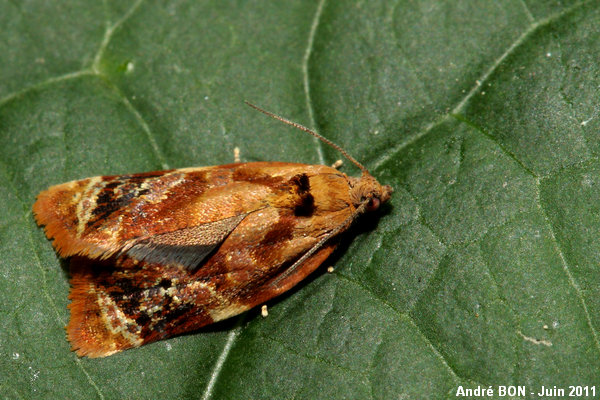
| Red-barred Tortrix (Ditula angustiorana (Haworth, 1811)) |

|
|
Scientific name: Ditula angustiorana (Haworth, 1811) Common name: Red-barred Tortrix Other names: Vine Tortrix French name: Order: Lepidoptera Suborder: Microlepidoptera Family: Tortricidae Subfamily: Tortricinae Wingspan: 14-18 mm for females, 12-15 mm for males. Biotope: Forests, orchards, parks and gardens. Geographic area: Europe, Asia Minor, North Africa, introduced to North America on the Pacific coast. Flight time: June-July. Number of generations : 1 Caterpillar: Yellowish green with and indistinct green dorsal stripe and a brownish head. Host plant: Many trees, deciduous and coniferous, and shrubs, Holly, Ivy, etc. This species is considered as a pest because of the damages done on fruit trees. |
The Red-barred Tortrix shows a sexual dimorphism. Females have pale brown to pale ochrous fore wings with black, dark brown and bluish marks. You can distinguish a dark oblique band next to the inner edge at the end of the basal area. When at rest, with both fore wings closed, the two oblique bands draw an upside down V-shaped mark. Following this you can distinguish a pale patch touching the inner edge in the discal area and darker marks in the postdiscal and submarginal areas. Males are darker, dark greyish brown to dark ochrous brown with purple brownish black, black and bluish marks. The hind wings are dark brown to greyish black. The caterpillars, which hatch out in summer, feed on leaves and on fruits. They over winter, still a small size, in shelters on buds or shoots. They will feed on buds, blossoms and growing fruits at next spring. They pupate within rolled leaves on the host plant or down in the litter. |
| [To know more about the Red-barred Tortrix] [Top] |

|
This Tortricidae moth has been able to show me the colour of its hind wings without opening its fore wings. There is a part that is outstretched between the two inner edges. |